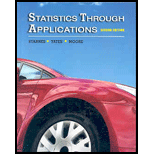
Concept explainers
a)
To perform hypothesis test for one sample proportion
a)
Answer to Problem 9.36E
There is not sufficient evidence to reject the claim that the coin is fair at 0.05 level of significance.
Explanation of Solution
Given:
Sample size = n = 250
Confidence level = 0.95
Formula:
Sample proportion:
Test statistic:
Calculation:
The sample proportion is,
Null and alternative hypothesis:
This corresponding to a two-tailed test, for which a z-test for one population proportion needs to be used.
Test statistic:
Test statistic z = 1.90
Using the P-value approach:
The p-value is p = 0.0574
Using excel formula, =NORMSDIST(1.90)
And a = 0.05
Since p = 0.0574 >0.05, it is concluded that the Null Hypothesis is not rejected.
Conclusion: There is not sufficient evidence to reject the claim that the coin is fair.
b)
To find the confidence interval for population proportion.
b)
Answer to Problem 9.36E
The 95% confidence interval is (0.4985, 0.6215)
Explanation of Solution
Given:
Sample proportion:
Confidence level = c = 95% = 0.95
Sample size = n = 250
Formula:
Margin of error:
Confidence interval:
Confidence level = c = 95% = 0.95
So, level of significance = a = 1-0.95 = 0.05
Z a/2 = 1.96 …Using excel
Margin of error is,
Therefore, the 95% confidence interval is,
Hence, we are 95% confidence that the true population proportion of heads is between 0.4985 and 0.6215.
Chapter 9 Solutions
Statistics Through Applications
Additional Math Textbook Solutions
Elementary Statistics (13th Edition)
Elementary Statistics: Picturing the World (6th Edition)
An Introduction to Mathematical Statistics and Its Applications (6th Edition)
Statistics for Psychology
Statistics: The Art and Science of Learning from Data (4th Edition)
Introductory Statistics (2nd Edition)
 MATLAB: An Introduction with ApplicationsStatisticsISBN:9781119256830Author:Amos GilatPublisher:John Wiley & Sons Inc
MATLAB: An Introduction with ApplicationsStatisticsISBN:9781119256830Author:Amos GilatPublisher:John Wiley & Sons Inc Probability and Statistics for Engineering and th...StatisticsISBN:9781305251809Author:Jay L. DevorePublisher:Cengage Learning
Probability and Statistics for Engineering and th...StatisticsISBN:9781305251809Author:Jay L. DevorePublisher:Cengage Learning Statistics for The Behavioral Sciences (MindTap C...StatisticsISBN:9781305504912Author:Frederick J Gravetter, Larry B. WallnauPublisher:Cengage Learning
Statistics for The Behavioral Sciences (MindTap C...StatisticsISBN:9781305504912Author:Frederick J Gravetter, Larry B. WallnauPublisher:Cengage Learning Elementary Statistics: Picturing the World (7th E...StatisticsISBN:9780134683416Author:Ron Larson, Betsy FarberPublisher:PEARSON
Elementary Statistics: Picturing the World (7th E...StatisticsISBN:9780134683416Author:Ron Larson, Betsy FarberPublisher:PEARSON The Basic Practice of StatisticsStatisticsISBN:9781319042578Author:David S. Moore, William I. Notz, Michael A. FlignerPublisher:W. H. Freeman
The Basic Practice of StatisticsStatisticsISBN:9781319042578Author:David S. Moore, William I. Notz, Michael A. FlignerPublisher:W. H. Freeman Introduction to the Practice of StatisticsStatisticsISBN:9781319013387Author:David S. Moore, George P. McCabe, Bruce A. CraigPublisher:W. H. Freeman
Introduction to the Practice of StatisticsStatisticsISBN:9781319013387Author:David S. Moore, George P. McCabe, Bruce A. CraigPublisher:W. H. Freeman





